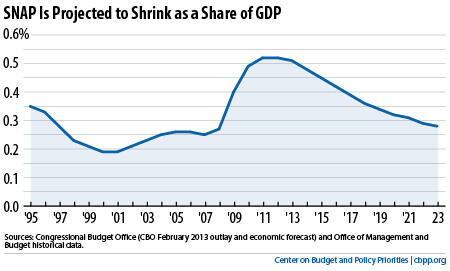BEYOND THE NUMBERS
Senator Jeff Sessions suggested in a Senate Budget Committee hearing this morning that recent growth in the Supplemental Nutrition Assistance Program (SNAP, formerly Food Stamps) and other safety net programs justifies cutting them now as part of deficit reduction efforts. But as the Center’s president Robert Greenstein testified during the hearing, and as the recently released Congressional Budget Office (CBO) projections confirm, SNAP’s recent growth is primarily due to the deep recession and prolonged recovery, and program spending will shrink as the economy improves.
SNAP’s growth shows that the program is working as designed. SNAP caseloads have risen significantly since late 2007, because the economic downturn dramatically increased the number of low-income households who qualify and apply for help from the program. CBO has confirmed that the deep recession was the primary cause of the increase in the number of SNAP participants. By boosting households’ income, SNAP is buffering families and communities from ongoing hardship caused by the weak recovery.
Two other factors of note have contributed to program growth. Each also shows that SNAP is doing its job.
- Economists rank SNAP as high “bang-for-the-buck” economic stimulus. The 2009 Recovery Act increased SNAP benefits as a way of delivering economic stimulus, and according to CBO, “about 20 percent of the growth in spending can be attributed to temporarily higher benefit amounts enacted in the [Recovery Act.]”
- The program is reaching a higher share of people who qualify, especially working families. The share of eligible people in households with earnings who participated in SNAP rose from about 45 percent in 2002 to about 65 percent in 2010.
SNAP spending growth has already slowed and is expected to reverse in the next few years. SNAP caseload growth and spending already have slowed substantially. Caseloads and spending will fall further in the coming years as households lose eligibility because of improved economic circumstances and the Recovery Act’s temporary benefit increase ends on October 31, 2013.
CBO projects that by fiscal year 2023, roughly the same share of the population will participate in SNAP as in 2008. SNAP spending will fall back to its 1995 level as a percentage of gross domestic product by 2019, and then fall below that level (see chart). SNAP, as currently structured, is not contributing to long-term budgetary pressures; no significant demographic or programmatic pressures will cause SNAP costs to grow faster than the overall economy.

SNAP’s growth doesn’t mean that it’s easy to cut in ways that don’t hurt low-income people. Ninety-five percent of SNAP spending goes to benefits that are used to purchase food. Most of the remaining 5 percent goes toward administrative costs, including reviews to determine that applicants are eligible, monitoring of retailers that accept SNAP, and anti-fraud activities.
